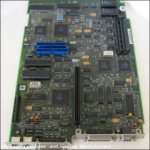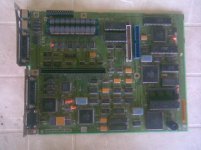Great Hierophant
Veteran Member
From the technical reference :
Serial - 8250, not 16450/16550
Floppy - only 250K transfer rates supported (no 1.2/1.44MB), power is supplied through the drive cable (40-pin).
Hard Drive - Interface is not MFM or or RLL based but is essentially 8-bit IDE with power supplied through the drive cable (44-pin). Default drive for system from IBM is a 20MB model, type 26 in BIOS table. 2 more types added to XT/286 table.
Parallel Port - Bidirectional, but bidrectional mode is enabled by I/0 0x65, bit 7.
Serial, Diskette, Video, Parallel Port and Hard Disk interfaces can be disabled by 0x65.
512KB standard, upgradeable to 640KB by 4x64x4 & 2x64Kx1 chips.
DMA0 does not refresh DRAM but is unavailable for I/O expansion use.
8MHz 8086 & 8087, 16-bit RAM, 8-bit ROM and I/O. ROM is 64KB and includes ROM BASIC.
-5v present on non-standard 12-pin power connector
Standard keyboard assumes no LEDs and may only be a unidirectional interface.
8xIRQs, 4xDMA, Segments C, D & E available for ROMs, whole 64KB address I/O decoded.
DB-25 for serial (male) and parallel (female), 6-pin mini-DIN for keyboard and mouse
PC Speaker has earphone jack which silences it when plugged in.
System RAM can be remapped if conflict occurs or a failure exists in first 128KB.
MCGA has separate 64KB of RAM, but no ROM BIOS. Two separate fonts contained in BIOS ROM, one supporting 8x8, one supporting 8x16.
MCGA can use up to 512 character font tiles and uses IRQ for a vertical retrace interrupt. It uses a 25.175MHz crystal.
Display connector is 14-pin berg and only supports ID bits 0 & 1.
Serial - 8250, not 16450/16550
Floppy - only 250K transfer rates supported (no 1.2/1.44MB), power is supplied through the drive cable (40-pin).
Hard Drive - Interface is not MFM or or RLL based but is essentially 8-bit IDE with power supplied through the drive cable (44-pin). Default drive for system from IBM is a 20MB model, type 26 in BIOS table. 2 more types added to XT/286 table.
Parallel Port - Bidirectional, but bidrectional mode is enabled by I/0 0x65, bit 7.
Serial, Diskette, Video, Parallel Port and Hard Disk interfaces can be disabled by 0x65.
512KB standard, upgradeable to 640KB by 4x64x4 & 2x64Kx1 chips.
DMA0 does not refresh DRAM but is unavailable for I/O expansion use.
8MHz 8086 & 8087, 16-bit RAM, 8-bit ROM and I/O. ROM is 64KB and includes ROM BASIC.
-5v present on non-standard 12-pin power connector
Standard keyboard assumes no LEDs and may only be a unidirectional interface.
8xIRQs, 4xDMA, Segments C, D & E available for ROMs, whole 64KB address I/O decoded.
DB-25 for serial (male) and parallel (female), 6-pin mini-DIN for keyboard and mouse
PC Speaker has earphone jack which silences it when plugged in.
System RAM can be remapped if conflict occurs or a failure exists in first 128KB.
MCGA has separate 64KB of RAM, but no ROM BIOS. Two separate fonts contained in BIOS ROM, one supporting 8x8, one supporting 8x16.
MCGA can use up to 512 character font tiles and uses IRQ for a vertical retrace interrupt. It uses a 25.175MHz crystal.
Display connector is 14-pin berg and only supports ID bits 0 & 1.


